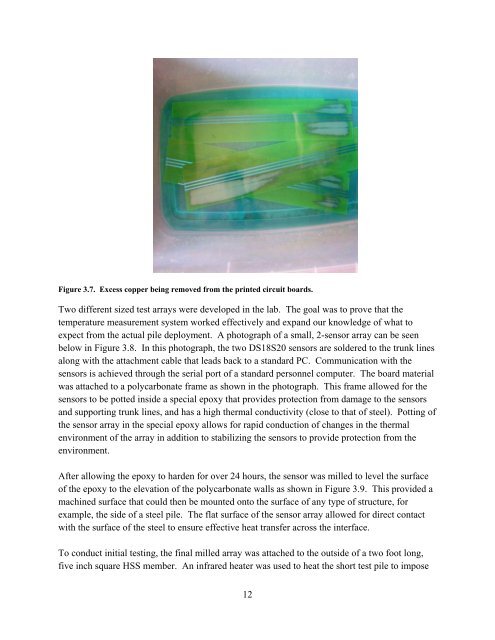Remote Health Monitoring for Asset Management
Remote Health Monitoring for Asset Management
Remote Health Monitoring for Asset Management
Create successful ePaper yourself
Turn your PDF publications into a flip-book with our unique Google optimized e-Paper software.
Figure 3.7. Excess copper being removed from the printed circuit boards.<br />
Two different sized test arrays were developed in the lab. The goal was to prove that the<br />
temperature measurement system worked effectively and expand our knowledge of what to<br />
expect from the actual pile deployment. A photograph of a small, 2-sensor array can be seen<br />
below in Figure 3.8. In this photograph, the two DS18S20 sensors are soldered to the trunk lines<br />
along with the attachment cable that leads back to a standard PC. Communication with the<br />
sensors is achieved through the serial port of a standard personnel computer. The board material<br />
was attached to a polycarbonate frame as shown in the photograph. This frame allowed <strong>for</strong> the<br />
sensors to be potted inside a special epoxy that provides protection from damage to the sensors<br />
and supporting trunk lines, and has a high thermal conductivity (close to that of steel). Potting of<br />
the sensor array in the special epoxy allows <strong>for</strong> rapid conduction of changes in the thermal<br />
environment of the array in addition to stabilizing the sensors to provide protection from the<br />
environment.<br />
After allowing the epoxy to harden <strong>for</strong> over 24 hours, the sensor was milled to level the surface<br />
of the epoxy to the elevation of the polycarbonate walls as shown in Figure 3.9. This provided a<br />
machined surface that could then be mounted onto the surface of any type of structure, <strong>for</strong><br />
example, the side of a steel pile. The flat surface of the sensor array allowed <strong>for</strong> direct contact<br />
with the surface of the steel to ensure effective heat transfer across the interface.<br />
To conduct initial testing, the final milled array was attached to the outside of a two foot long,<br />
five inch square HSS member. An infrared heater was used to heat the short test pile to impose<br />
12

















